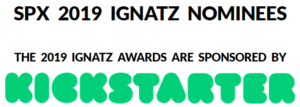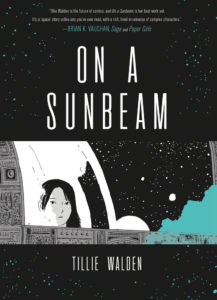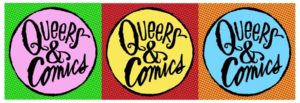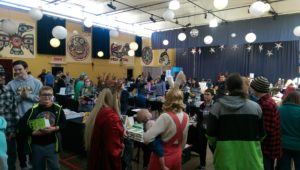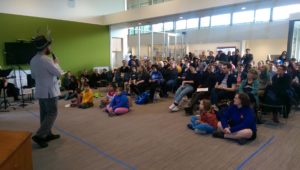We All Win
The Ignatz Awards are maybe the most democratic of all the major comics awards — if you attend SPX, you get a ballot. At least, if you attend on Saturday, because they tally the votes through the day and the bricks are given out Saturday night, but you get the idea. They also, traditionally, have a very good jury, who provide a very good slate of nominees. This year’s nominees have just been announced, and it’s a cornucopia of quality.
As readers of this page know, I am a major fan and promoter of the work of Rosemary Valero-O’Connell, and her work on Laura Dean Keeps Breaking Up With Me could have come from a 20 year veteran of comics, rather than somebody working on their first book who’s still in the first half of their 20s. It’s no surprise that Valero-O’Connell was nominated for Outstanding Artist, Oustanding Graphic Novel, and Oustanding Story, the later two categories being co-nominations with writer Mariko Tamaki. I’m thrilled everytime I am reminded that so many people loved this book as much as I did.
The other multiple nominee that caught my eye, and of which I am a tremendous fan, is The Nib; Matt Bors’s marvelously eclectic endeavour has a history with SPX, debuting their hardcover collection there a few years back. The Nib was nominated as Oustanding Series (for the print magazine), and two issues (Family, and Death) were separately nominated for Oustanding Anthology. Well done Bors, and the entire group of editors and contributors.
But those are not the only deserving nominees; let’s take a look at who we at Fleen will be rooting for.
- Outstanding Artist: In addition to Valero-O’Connell, you’ve got Lucy Knisely for Kid Gloves, which I also loved. I’m not familiar with Koren Shadmi on Highwayman, Sloane Leong’s Prism Stalker, or Ezra Clayton Daniels on Upgrade Soul.
- Outstanding Collection: Love Letters To Jane’s World by Paige Braddock, Girl Town by Carolyn Nowak, Dirty Plotte by Julie Doucet, Leaving Richard’s Valley by Michael DeForge, and This Woman’s Work by Julie Delporte. I have no clear preference, but all these creators are skilled and worthy of the win.
- Outstanding Anthology: In addition to the two issues of The Nib, you have Electrum (edited by Der-shing Helmer), Wayward Sisters (edited by Alison O’Toole), and We’re Still Here: An All-Trans Comics Anthology (edited by Tara Avery and Jeanne Thornton). My preference is for The Nib, only because they do so many different kinds of comics in each issue. I suspect they’ll split the vote, though.
- Outstanding Graphic Novel: In addition to Laura Dean, you’ve got Upgrade Soul by Ezra Clayton Daniels, Woman World by Aminder Dhaliwal, Highwayman by Koren Shadmi, and Gender Queer by Maia Kobabe. I believe I made my preference clear, but Kobabe’s been doing some damn good comics, including Gender Queer.
- Outstanding Minicomic: Trans Girls Hit The Town by Emma Jayne, Gonzalo by Jed McGowan, Silver Wire by Kriota Willberg, Cherry by Inés Estrada, and YLLW YLLW YLLW by Mar Julia. Not familiar with any of the books or creators. If I get the chance to vote, I might throw it to a dude because so maybe at least one dude wins. ‘Cause damn, women having been outshining the dudes at the Ignatzen for a couple years now.
- Outstanding Comic: Lorna by Benji Nate, Infinite Wheat Paste #7 by Pidge, The Saga Of Metalbeard by Joshua Paddon and Matthew Hoddy, Egg Cream by Liz Suburbia, and Check, Please!: #Hockey by Ngozi Ukazu. I do love me some comics about gay collegiate hockey bros, but I’m surprised to see the nomination in print but not for …
- Outstanding Online Comic: Isle Of Elsi by Alec Longstreth, That’s Not My Name! by Hannako Lambert, What Doctors Know About CPR by Nathan Gray, About Face by Nate Powell, and Full Court Crush by Hannah Blumenreich.
I find it interesting that despite the rules specifying an online comic can be an individual comic, continuing storyline comic or strips, and the only real restriction being that it appears on the web before print, that there’s a real tendency towards shorter works. Three of the nominees (Name, CPR, and Face) are arguably essays in comic form (any one of them could have appeared at The Nib), and Full Court is a 16 page short story. Only Longstreth’s Elsi is a traditional (whatever that means) plot-based, ongoing webcomic.
The extremely wide-open criteria means that this category, more than any other, varies widely from year to year, based on the jury’s personal views of what a good online comic looks like. I am precisely 50% in favor of having a narrower definition so there can be some consistency, and 50% in favor of the variety that is rewarded by the present system.
Because of my avocational interests, I am pulling for What Doctors Know About CPR (which really, really could have appeared in The Nib’s Death issue).
- Promising New Talent: Haleigh Buck, Ebony Flowers, Emma Jayne, Mar Julia, and Kelsey Wroten. I’ll have to dig into their work, but I’m really liking the looks of what Jayne and Julia are doing.
- Outstanding Story: In addition to Laura Dean, you’ve got Sacred Heart Vol 2 Part 1: Livin’ In The Future by Liz Suburbia, Sincerely, Harriet by Sarah Winifred Searle, Woman World by Aminder Dhaliwal, and The Dead Eye And The Deep Blue Sea by Vannak Anan Prum. Although I’m a tremendous fan of Searle’s work, Laura Dean remains my favorite book of the year until The Midwinter Witch arrives to make its case.
Speaking of which, I’m very surprised to not see Molly Ostertag and/or The Hidden Witch in any category, nor Tillie Walden and/or On A Sunbeam anywhere in the nominations. Ah well, if I want the nominations to be perfect, all I have to do is become a comics writer and/or artist, and have a distinguished enough career that people in the industry think enough of me that I’m asked to be part of the jury. Simple.
The Ignatz bricks will be distributed starting at 9:30pm on Saturday, 14 September, at the Small Press Expo in Bethesda, Maryland.
And hey, if the competition for the Ignatzen is a little to wholesome, there will be some virtual blood in a head-to-head original character deathmatch tournament sponsored by Abbadon over at Kill Six Billion Demons’s Discord. Registration’s open until they get 64 entrants.
Spam of the day:
Kontrollnummer- FX 75/463. (Kontrollnummer- FX 75/463.)
Garbage bags and much more.
I am less concerned by the German language pitch for what appears to be general shipping supplies than I am for the inclusion on the list of Solvent. All kinds. I get the feeling that you are selling to the serial killer market.
